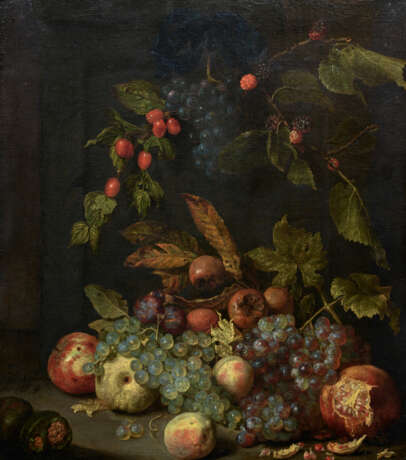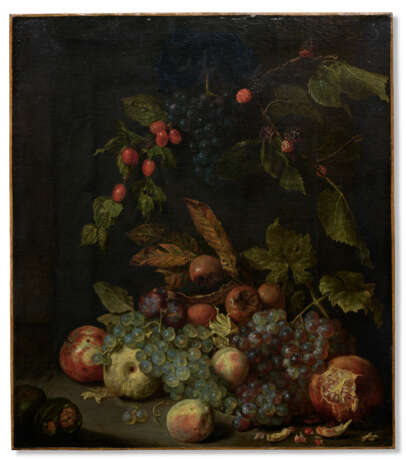ID 1387050
Lot 29 | GUILLIAM GABRON (ANVERS 1619-1678)
Estimate value
€ 10 000 – 15 000
Nature morte aux raisins, pommes, nèfles, mûres, prunes et autres fruits
signé 'Gul. Gabron / f.' (en bas, à gauche)
huile sur toile, sans cadre
68 x 60 cm (26 ¾ x 23 2/3 in.)
Provenance
Oscar Nottebohm (1865-1935), Anvers, Belgique ; sa vente après décès, Palais des Beaux-Arts, Bruxelles, 17 décembre 1957, (Me Van den Bergen), lot 34.
Collection Onzea-Govaerts, Belgique.
Literature
M.-L. Hairs, Les peintres flamands de fleurs au XVIIe siècle, Bruxelles, 1965, p. 375.
E. Greindl, Les peintres flamands de nature morte au XVIIe siècle, Sterrebeek, 1983, p. 354, n°5 (réédition Paris, 1956, p. 167).
Exhibited
Anvers, Antwerpsche Propagandaweken. Tentoonstelling van kunstwerken uit Antwerpsche Verzamelingen, 20 avril-19 mai 1935, n°60.
Further details
GUILLIAM GABRON (1619-1678), STILL LIFE WITH GRAPES, APPLES, MEDLARS, BLACKBERRIES, PLUMS AND OTHER FRUITS, OIL ON ON CANVAS, SIGNED (LOWER LEFT), UNFRAMED
Warm, amber colours mark this autumnal painting by the Antwerp painter Guilliam Gabron (1619-1678), by whom only ten signed works are known. A stone slab is piled high with grapes, apples, peaches, a pomegranate, medlars and plums. Above this opulent still life hangs a plum branch, heavy with fruit, brambles and a bunch of black grapes adorned with a blue ribbon. Two walnuts in the bottom left-hand corner complete the composition.
Following the customs of his time, Gabron takes the viewer through the elements of his composition in two distinct narrative fields. The first of these concerns religious symbolism. The artist has included the grapes as a reference to communion wine, a reference that is relatively easy even for a modern viewers to comprehend. The religious symbolism of the walnuts, on the other hand, is less easy for a contemporary viewer to grasp. During Gabron's lifetime, the walnut, made up of three distinct parts: the green outer husk, the shell and the kernel, were used as a symbol of the Trinity. According to Saint Augustine, it also symbolised Christ's Passion: the husk represented His flesh, which bore the wounds, the nut His inner sweetness, and the shell the Cross on which He died. Gabron emphasises the importance of the walnuts by placing them almost as the source of light in the composition: this golden glow seems to spring from the lower left-hand corner, highlighting the succulent fruits above.
The second narrative path relates to Greek mythology. Gabron carefully chose to paint six pomegranate seeds stone slab at lower right. These refer to the legend of Persephone. Abducted by Hades, King of the Underworld, to be his queen, Persephone, daughter of the goddess Demeter, refused to eat. Weak and exhausted, she finally gave in and ate six pomegranate seeds. When her mother, who had been desperately searching for her everywhere, finally found her, Hades told her that, having consumed the food of the underworld, Persephone was never allowed to leave. Demeter, distraught, asked Zeus for help, and Zeus decided that Persephone should remain in the Underworld for six months each year, one month for each seed, and that she could return to her mother for the remaining six months. This myth explains the change of seasons. The months spent by Persephone in the Underworld correspond to autumn and winter, which makes the presence of the seeds in this autumnal composition highly relevant.
| Applied technique: | Oil on canvas |
|---|---|
| Art style: | Old Masters |
| Genre: | Still life |
| Place of origin: | Belgium, Western Europe, Europe |
| Auction house category: | Paintings, Watercolors, Drawings, Paintings |
| Applied technique: | Oil on canvas |
|---|---|
| Art style: | Old Masters |
| Genre: | Still life |
| Place of origin: | Belgium, Western Europe, Europe |
| Auction house category: | Paintings, Watercolors, Drawings, Paintings |
| Address of auction |
CHRISTIE'S 8 King Street, St. James's SW1Y 6QT London United Kingdom | |
|---|---|---|
| Preview |
| |
| Phone | +44 (0)20 7839 9060 | |
| Buyer Premium | see on Website | |
| Conditions of purchase | Conditions of purchase |





